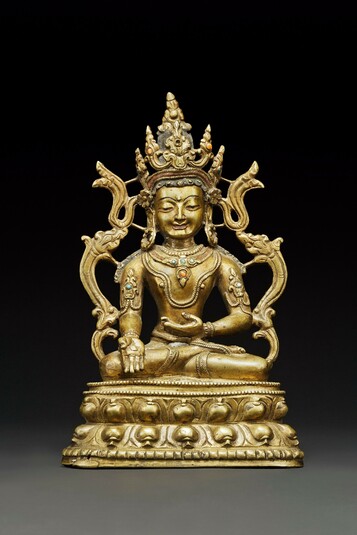
Item: Ratnasambhava Buddha - (Peaceful Appearance)
| Origin Location | Tibet |
|---|---|
| Date Range | 1300 - 1399 |
| Lineages | Buddhist |
| Material | Metal |
| Collection | Private |
Classification: Deity
Appearance: Peaceful
Gender: Male
Ratnasambhava, Buddha (Tibetan: rin chen jung den, sang gye): a principal buddha within Vajrayana Buddhism representing the qualities of enlightenment and residing in the southern quarter of a mandala.
Ratnasambhava is primarily associated with Vajrayana Buddhism and originates in the Tantric Literature of the Yoga and Anuttarayoga Tantra classes.
"Arising in the southern direction is Ratnasambhava on a horse, lotus and sun throne; with a body yellow in colour the right hand is placed in the mudra of supreme generosity." (Dragpa Gyaltsen, 1147-1216).
"In the middle of a ground of lapis lazuli is a jewelled throne - bestowing numerous attainments. On top is a thousand petalled lotus - unstained by worldly faults. Wisdom and means appear as a sun and moon. Above this, as the essence of all qualities is Ratnasambhava. With a radiant body having the colour of blazing gold, one face, two hands, the right is in supreme generosity -- fulfilling the wishes of beings. Performing meditative stabilization, the left is in the mudra of meditation. Seated with the two feet in vajra posture - method and wisdom, and having the thirty-two marks and eighty examples of excellence. For the purpose of satisfying - well adorned with jewels and beautiful silk garments. Adorning the body are a million light rays issuing and returning; having a voice possessing sixty separate tones and a mind continuum of immeasurable pristine awareness." (Bhikshu Konchog Ozer, 15th century).
Jeff Watt 9-2005 [image added 2-2014]
Sculpture: Monastic Period (Tibet, 13-14th century)
Buddhist Deity: Ratnasambhava Buddha Main Page
Sculpture: Monastic Period (Sambhogakaya Buddha)
Collection of WGA

